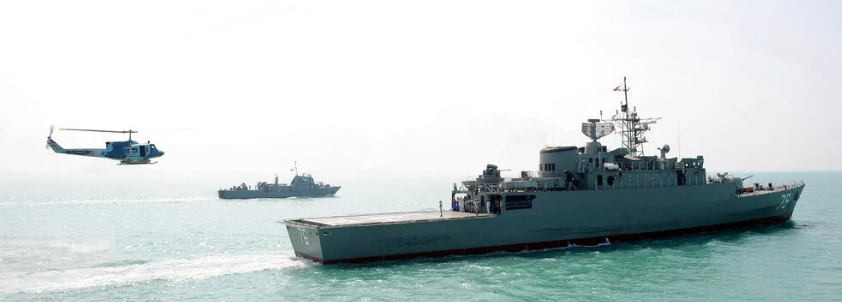Iran has long been seen as a powerful player in the Middle East, mostly because of its land forces and influence in regional politics. But over the past few years, the country has been quietly strengthening its naval forces. Iran is now using advanced submarines, fast-moving missile boats, and well-positioned military bases to increase its presence in the Persian Gulf and beyond. As global tensions rise, especially with countries like Israel, the United States, and some Gulf states, Iran’s naval development has become an important topic of concern and interest.
Dual Power Understanding the Two Naval Forces in Iran’s Military Structure
Iran’s naval power is split between two powerful organizations. The first is the Iranian Navy (IRIN). This is the country’s regular navy, trained to operate in the open oceans, like the Arabian Sea, Gulf of Oman, and even into the Indian Ocean. Its role is to show Iran’s strength in international waters and defend shipping routes important to the country’s economy.
The second is the Islamic Revolutionary Guard Corps Navy (IRGCN). This force focuses on operations closer to home, especially in the Persian Gulf and the Strait of Hormuz. These waters are narrow, crowded, and extremely important for global oil trade. The IRGCN uses fast, light boats and surprise tactics to challenge foreign ships, especially those from the U.S. Navy.
Are Iran’s Submarines Silent or Deadly? Exploring Their Underwater Arsenal
Submarines are often called “silent killers” of the sea, and Iran has been investing in them heavily. Iran’s most used submarine is the Ghadir-class mini-sub, which can easily move in the shallow waters of the Persian Gulf. These submarines are hard to detect and can lay mines or fire torpedoes at ships. Their size and stealth make them a dangerous tool, especially in coastal battles.

Iran also owns Kilo-class submarines, bought from Russia, which can travel longer distances and stay underwater for extended periods. These are more powerful and can be used for deep-water missions, even outside the Gulf.Perhaps more impressive is Iran’s ability to build home-grown submarines, like the Fateh-class. These submarines have modern systems, and Iran claims they are equipped with guided missiles, although this is not confirmed. If true, this would be a major leap in Iran’s ability to threaten large naval forces from a distance.
The Role of Iran’s Coastal Military Bases in Power Projection
Iran has developed a network of naval bases along its southern coast, especially near Bandar Abbas, Jask, and Chabahar. These bases allow Iran to quickly launch military operations, monitor foreign ships, and protect its territorial waters. One of the most strategic locations is near the Strait of Hormuz, a narrow waterway through which about 20% of global oil passes. By having strong bases nearby, Iran can control traffic or threaten to close this waterway in case of conflict, which would affect oil prices worldwide.
Iran is also building up bases near the Makran coast, which gives them easier access to the Arabian Sea. This helps Iran extend its influence and avoid being blocked during wartime. These bases also serve as storage and refueling stations for submarines and warships.
Modern Naval Weapons, Speedboats, and Drone Warfare on the Sea
Iran has also shown its growing capability in unmanned naval drones. These remote-controlled boats can carry explosives or gather information without risking a pilot. Iran claims to have developed drone boats capable of suicide missions and long-distance surveillance. In addition, the country is investing in cruise missiles designed to strike ships and ports. Some of these missiles are launched from ships, others from land bases near the sea. These systems make Iran’s coastline heavily protected and hard for foreign navies to approach.
Iran’s Naval Warfare Strategy Defending with Asymmetry and Surprise
Iran’s approach to naval warfare is not about winning with size it’s about strategy and surprise. The country knows that its navy cannot match the size or technology of the U.S. Navy or NATO forces, so it uses asymmetric tactics. This means fighting in smart, unexpected ways that turn the battle to their advantage.
For example, using swarm attacks with dozens of small boats can overwhelm a large destroyer. Laying mines in narrow waterways can stop traffic and damage ships. Submarines can silently follow or shadow foreign ships for days, gathering intelligence. Iran also practices “strategic messaging” through military drills and missile tests. By holding drills near international waters, Iran sends a clear message: we are watching, and we are ready to act if threatened.
How Iran’s Navy Sends a Political Signal
Recently, Iran has increased its naval presence due to rising tension in the region especially as conflicts grow between Israel and its neighbors, and as U.S. ships move closer to Iranian waters. Iran has sent submarines into the Red Sea, warships toward Africa, and taken part in joint drills with Russia and China.

These actions are not just about war they are about sending a message to the world: Iran is strong, self-reliant, and capable of defending its interests. Iran says its navy is built for defense and peace, but many nations see it as a growing challenge to freedom of navigation.
Iran’s Naval Strength Is Now a Global Talking Point
Iran’s navy is no longer small or outdated. With silent submarines, advanced weapons, fast attack boats, drone technology, and well-positioned bases, Iran has built a modern and flexible naval force. While it still cannot compete in size with superpowers, its ability to create danger and disruption in key waterways makes it an important global military player.
As the world watches the Middle East closely, Iran’s naval capabilities will likely play a central role in future events both in diplomacy and in defense.

